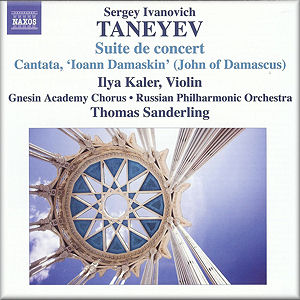 |
 |
|


alternatively
CD:
AmazonUK
AmazonUS
Download: Classicsonline
|
Sergei TANEYEV (1856-1915)
Cantata, John of Damascus (Ioann Damaskin), Op. 1a (1884)
[26:10].
Suite de Concert, Op. 28b (1909) [46:05].
 Gnesin
Academy Chorusa; Ilya Kaler (violin)b;
Russian Philharmonic Orchestra/Thomas Sanderling. Gnesin
Academy Chorusa; Ilya Kaler (violin)b;
Russian Philharmonic Orchestra/Thomas Sanderling.
rec. Studio 5, Russian State Radio & TV Company KULTURA, Moscow, Russia,
2-6 May and 13 September 2007. DDD
 NAXOS 8.570527 [72:15] NAXOS 8.570527 [72:15] 
|
|
|
Mikhail Pletnev’s DG recording of John of Damascus -
recorded in 2000 - was a major step forward in the raising of
Taneyev into the public’s consciousness. It was reviewed
here on MusicWeb by Ian
Lace - you can find my comments on the AmazonUk website.
Although this was Taneyev’s official Opus One, these are
some forty other works that precede it. The cantata is dedicated
to the memory of Nikolai Rubinstein and is a meaty, heartfelt
response to words by Alexei Tolstoy. Melodic material is often
chant-based: specifically, the 1772 version of “Rest with
the Holy Ones”. Pletnev’s recording team was excellent,
and there is real presence to his recording. Pianissimi are
spellbindingly rendered; fortissimi blaze. His chorus,
the Russian State Chamber Choir, is magnificent, particularly
in the quieter moments.
The Naxos recording is up-front, but the Russian Philharmonic’s
strings lack the depth of tone of Pletnev’s ensemble. Pletnev
is routinely faster than Sanderling, too: Pletnev’s three
movements are 13:03, 2:41 and 7:04 as against Sanderling’s
14:59, 3:01 and 8:10. As the Naxos first movement (Adagio
non troppo) proceeds, however, a more deeply felt interpretation
begins to take shape, itself scuppered later by a lack of clarity
of texture. That said, the lustiness of the choral singing of
the final movement’s vigorous fugue almost makes up for
previous failings. Almost. Taneyev’s John of Damascus can
make real emotional impact, as Pletnev proves; Sanderling provides
a recording of a curio.
Pletnev’s coupling (Rachmaninov The Bells) is very
satisfying; it is actually the other way around - the Taneyev
is the ‘filler’. Here on Naxos, it is the Suite
de Concert, a rather popular work - there are at least five
alternatives, including several by David Oistrakh. This was Taneyev’s
first work for violin and orchestra. It is given here in a performance
of undeniable eloquence by Ilya Kaler. The Prelude is of some
substance: 8:14 in duration. Taneyev’s inspiration never
wavers. There follows a selection of dances (Gavotte and the
final Tarantella) along with a Theme and Variations and a “Märchen” (Fairy
Tale). At 9:14, the Fairy Tale is the longest movement. It is
pure magic in its scoring, and Kaler’s way with the high
writing is most captivating. Fugal form is in evidence - this
time a brief (2:08) double fugue. But it is moments like the
sweet lyricism that surfaces in the work’s final minutes
that are truly memorable. The final Tarantella has real grit.
Anastasia Belina’s excellent liner-notes make tantalising
reference to Taneyev’s opera, Oresteia of 1894.
One can dream … perhaps just a reissue of the Melodiya
recording of 1978? - with orchestra and chorus of the Belorussian
State Opera conducted by Tatiana Kolomizheva. The Melodiya was
once available on Olympia OCD195/A/B.
An interesting introduction, perhaps, to Taneyev, but both pieces
are better served elsewhere.
Colin Clarke
|
|

